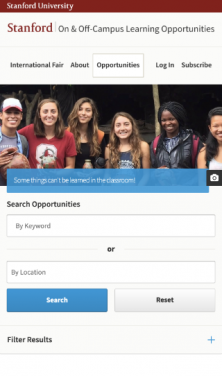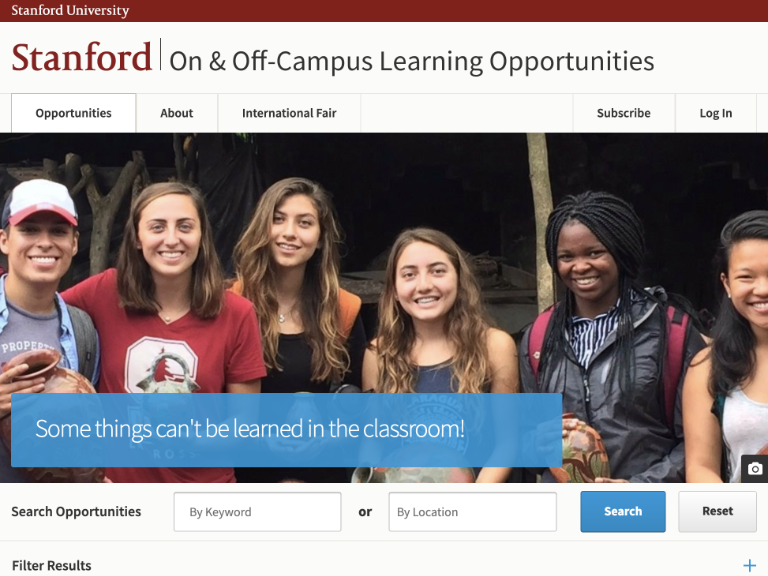Stanford On & Off-Campus Learning Opportunities was built by Aten Design Group and Stanford's Research Information Technology and Innovation team (RITI). The platform facilitates a multi-faceted application process whereby students are awarded academic experiences that take place all over the world. The process implements highly customizable application forms, a flexible and robust workflow, third-party review via customizable metrics, and a variety of features for sharing information and communicating during the application evaluation process.
Stanford On & Off-Campus Learning Opportunities features:
- Single sign on (SSO) via Stanford's SUNet authentication system
- Integration with Stanford's student records API that provides academic data to evaluators
- A robust email notification system
- Automated PDF generation and merging to present long form, multi-asset applications as a single, easy-to-review file
- A variety of distinct permissions and user experiences for multiple roles including Program Officers, Applicants, Reviewers, Recommenders, and Student Program Officers — among others
- On-the-fly review packet preparation to export dozens or hundreds of applications as raw CSV data, or PDF packets organized by student name and archived into a single Zip file
- A variety of user feedback interfaces to assist in iterative improvement and feature development
Stanford On & Off-Campus Learning Opportunities helps thousands of Stanford students browse and apply for hundreds of academic opportunities, and engage with highly customizable application processes. The platform features Team functionality that allows groups of faculty users to work together to manage dozens or hundreds of applicants, as well as recruit Stanford students to perform limited management tasks.
The platform is the beneficiary of ongoing development cycles, and new major features are introduced periodically.
Development of Stanford On & Off-Campus Learning Opportunities (SOLO) began in late 2015 on Drupal 7. The platform quickly became a viable product with a significant user base, and has since been the recipient of ongoing fast development cycles. New feature sets and iterative improvements are introduced frequently, and project stakeholders are regularly engaged to develop feature wishlists. When Drupal 7 end-of-life became a real concern in late 2021, our team was still building momentum, bringing in new stakeholders, and addressing user needs on a regular basis — in short, we were in no position to undertake a slow and expensive rebuild.
Backdrop CMS quickly became the favorite alternative — primarily because it promised a short path to overcoming end-of-life concerns while protecting our considerable investment in custom development. The savings we hoped to realize by pursuing Backdrop CMS would mean a quick return to new feature production, stakeholder engagement, and the further development of an already active and successful platform.
The entire upgrade process — including a test-suite upgrade to Cypress and move to Pantheon — took about three calendar months and 550 person-hours. That's surprisingly fast considering SOLO was the product of more than six years of continuous development. When compared to our rough estimate of 3500-4000 hours for a Drupal 9 upgrade (based on dozens of Drupal 8 / Drupal 9 builds, upgrades, and migrations), it's hard to imagine how a different approach could have served us better.
SOLO went live in late January of this year — just in time to serve hundreds of thousands of pages in February during peak application season. The site is identical with its former self both visually and functionally, and it performs significantly better in terms of average page load time. For our users the transition was near seamless, as was our return to iterative improvements and new feature planning. All in all it has been a big win for our team, our platform, and most importantly, our users.


